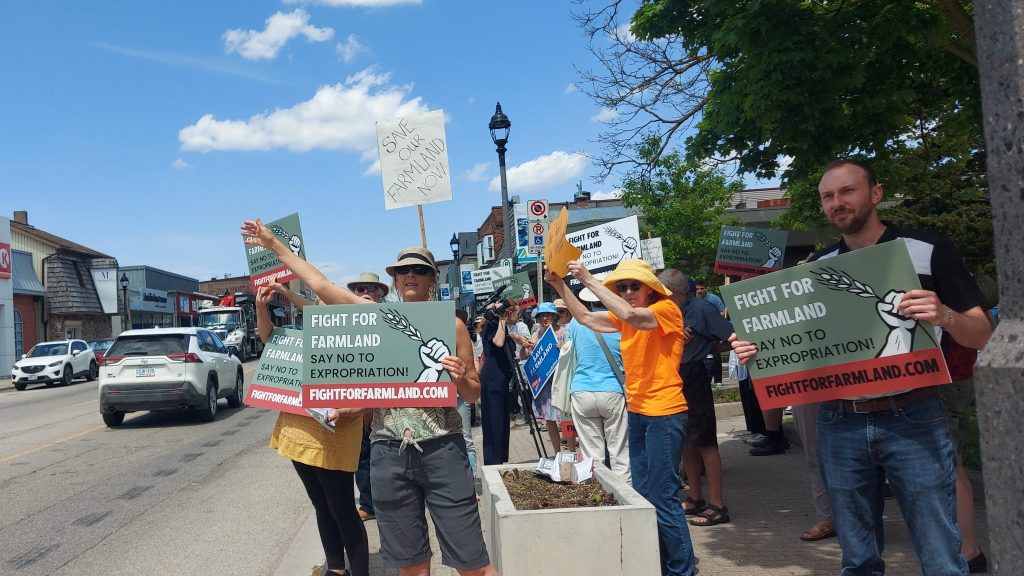Fight for Farmland in Wilmot could turn into legal battle: Spokesperson

Despite the Region of Waterloo’s announcement last week that it has successfully purchased almost one third of the 770 acres of land in Wilmot its been eyeing, those against the assembly aren’t backing down.
The Region of Waterloo has been pursuing what its calling “shovel-ready” land in the Township for nearly five months.
Officials said it’s for a future large-scale development that is necessary for long-term economic and job growth.
Advertisement
But a group of farmers and residents in Wilmot have been raising the alarm and banded together as they fight for answers, and the dispute may end up before the courts.
Alfred Lowrick is a spokesperson for the Fight for Farmland group and appeared on The Mike Farwell Show on Wednesday. He said they’d prefer if they do not have to take a legal route in their ongoing battle.
“It’s expensive and we’re just a volunteer group,” he said. “However, if need be, we will move down that road. We’d prefer to understand what’s going on and have the region back away from this.”
Lowrick said he heard Wednesday morning that work was already starting on some of the newly purchased farmland.
Advertisement
“As of this morning, they’re taking down a corn field which is now going to be destroyed; 260 acres of corn that was planted for feed for cattle. They could’ve waited another month, I thought, to make it viable — now it’s just going to be fertilizer,” Lowrick said.
The group continues to question why the specific site was chosen for potential development.
Last week, the Region of Waterloo issued a statement that included a list of the land’s desirable characteristics.
One of those was, “Not located on the Regional Recharge Zone, which protects Waterloo Region’s drinking water.”
Kevin Thomason, who lives in Wilmot and is the Vice-Chair of the Grand River Environmental Network, said he’s taking issue with that attribute.
Advertisement
“Yes, it’s not on the groundwater recharge moraine area — it’s 300 metres from it. So it’s not like it’s greatly separated, it’s not like water can’t travel a couple hundred metres,” he said. “They’re locating it in the Nith River watershed that’s already at its assimilative capacity, meaning the Nith River is already flooding and is already so polluted that they can’t put anymore wastewater or sewage into it. So instead they’re going to take the capacity from Kitchener that was built to service the core renewal in downtown Kitchener and Uptown Waterloo and area, and instead, pipe it all the way out to Wilmot.”
Both Thomason and Lowrick are also questioning recent comments from Regional Chair Karen Redman, who said a new septic line would be needed from the township site to the Kitchener sewage treatment plant.
Lowrick said as the former Executive Director of K-W Oktoberfest, he understands that economic development is critical and vital for the community. However, he isn’t sure the 770 acres in Wilmot are the best spot.
“We don’t think it is. We have no documentation to indicate that is the right spot,” said Lowrick. “I think we have other locations that our group has come that have been highlighted, we don’t think the Region has done their homework on this.”
There’s also been a back and forth on the Regional Official Plan and whether the Wilmot development plans were included.
Advertisement
The region says it was, but Thomason says “barely.”
“In the Regional Official Plan, there’s one mention of the mega site. There’s more than 141 mentions of the need for farmland, farmland protection, efforts to control uban sprawl, and things like that,” said Thomason. “So one versus 140 hardly seems balanced.”
The Region of Waterloo said last Thursday that “on-site technical analysis” would soon begin in Wilmot and that while it continues to engage with the landowners, details on the negotiations remain confidential.
